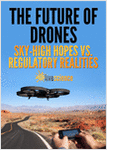 | When Raphael Pirker needed overhead shots for a commercial he was filming at the University of Virginia, instead of spending thousands of dollars to rent a helicopter, he attached a camera to a 5-lb. (2.3 kilograms) model airplane, creating a custom drone to capture high-flying aerial views of the campus. A year earlier, the 29-year-old photographer piloted a similar drone around the Statue of Liberty in New York, buzzing the monument's iconic crown and recording stunning close-up views of Liberty Island and downtown Manhattan. Drones have been used by the military for decades, but Pirker's videos offer a glimpse of just one possible way these robotic fliers could be used in the future. As advances in technology have made drones smaller and more accessible, their potential applications are extending far beyond their use as warfighters for the military or toys for hobbyists. And people are taking notice. In December 2013, Amazon founder Jeff Bezos created a buzz throughout the tech world when he introduced the idea of using drones to deliver goods to online shoppers. The proposal sparked people's imaginations for how drones could be used commercially — bringing to mind images of city skies full of delivery drones carrying parcels to people's doorsteps. With this download you will also receive free weekly coverage on the latest science news from our LiveScience Daily eNewsletter. Request Free! |
